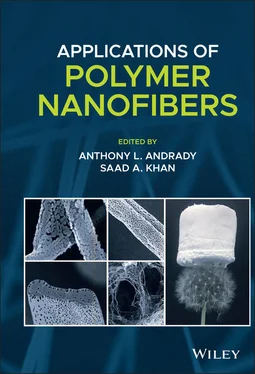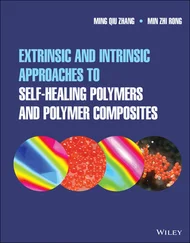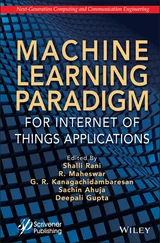Applications of Polymer Nanofibers
Здесь есть возможность читать онлайн «Applications of Polymer Nanofibers» — ознакомительный отрывок электронной книги совершенно бесплатно, а после прочтения отрывка купить полную версию. В некоторых случаях можно слушать аудио, скачать через торрент в формате fb2 и присутствует краткое содержание. Жанр: unrecognised, на английском языке. Описание произведения, (предисловие) а так же отзывы посетителей доступны на портале библиотеки ЛибКат.
- Название:Applications of Polymer Nanofibers
- Автор:
- Жанр:
- Год:неизвестен
- ISBN:нет данных
- Рейтинг книги:4 / 5. Голосов: 1
-
Избранное:Добавить в избранное
- Отзывы:
-
Ваша оценка:
- 80
- 1
- 2
- 3
- 4
- 5
Applications of Polymer Nanofibers: краткое содержание, описание и аннотация
Предлагаем к чтению аннотацию, описание, краткое содержание или предисловие (зависит от того, что написал сам автор книги «Applications of Polymer Nanofibers»). Если вы не нашли необходимую информацию о книге — напишите в комментариях, мы постараемся отыскать её.
Explore a comprehensive review of the practical experimental and technological details of polymer nanofibers with a leading new resource Applications of Polymer Nanofibers
Applications of Polymer Nanofibers
Applications of Polymer Nanofibers
Applications of Polymer Nanofibers — читать онлайн ознакомительный отрывок
Ниже представлен текст книги, разбитый по страницам. Система сохранения места последней прочитанной страницы, позволяет с удобством читать онлайн бесплатно книгу «Applications of Polymer Nanofibers», без необходимости каждый раз заново искать на чём Вы остановились. Поставьте закладку, и сможете в любой момент перейти на страницу, на которой закончили чтение.
Интервал:
Закладка:
1.5 Electrospinnable Systems
A vast range of synthetic and biopolymers have been electrospun. Electrospinning low molecular weight polymers, polyelectrolytes, and some biomacromolecules have been limited. A common approach to form fibers from such materials is to blend the nonelectrospinnable polymer with an easily electrospinnable polymer (Schiffman and Schauer 2008; Wang et al. 2015; Wendorff et al. 2012; Tang et al. 2012; Saquing et al. 2013). The carrier polymer is typically high molecular weight that forms a well‐entangled network at low concentrations (Schiffman and Schauer 2008; Saquing et al. 2013). For example, biopolymers such as chitosan or alginate are often blended with PEO (Schiffman and Schauer 2008; Saquing et al. 2013). The electrospinnable polymer increases the elasticity of the blend to enable formation of nanofibers (Yu et al. 2006).
1.5.1 Nonpolymer Electrospinning
Traditionally, electrospinning has been limited to high molecular weight polymers. Generally, polymer networks are thought to provide molecular, entanglement, and elasticity to achieve uniform fibers (Shenoy et al. 2005; Yu et al. 2006). Polymer‐free electrospinning explores fabricating nanoscale fibers from small molecules and offers potential for new applications ( Table 1.2).
Phospholipids and Gemini surfactants, amphiphilic molecules with molecular weights of ~700 and ~300 g/mol, respectively, for example, have been electrospun into uniform fibers (McKee et al. 2006; Cashion et al. 2010). Both amphiphilic molecules self‐assemble into spheres or worm‐like micelles in solution. The worm‐like micelles behave analogous to polymer chains and can entangle due to hydrogen bonding and other intermolecular interactions (McKee et al. 2006). In the case of Gemini surfactants, the transition from globular to branched micelle network resulted in an increase in viscoelasticity of the solution and electrospinning of continuous fibers (Cashion et al. 2010). The fibers are of interest for controlled release applications (Cashion et al. 2010; Hemp et al. 2014).
Table 1.2 Nonpolymer electrospinning systems.
| Material | Solvent | Concentration | Fiber diameter (μm) |
|---|---|---|---|
| Phospholipids (McKee et al. 2006) | CHCl 3/DMF | 43 wt% | 2.8 |
| Gemini surfactants (Cashion et al. 2010) | Water/methanol | 28–30 wt% | 0.9–7 |
| 42–44 wt% | 4–5 | ||
| Phosphonium Gemini surfactants (Hemp et al. 2014) | Chloroform | 52 wt% | 0.7–1.3 |
| HPβCD (Celebioglu and Uyar 2012; Manasco et al. 2012) | Water, DMF, DMAc | 120–160% (w/v) | 0.7–1.4 |
| Water | 70 wt% | 1–1.2 | |
| HPγCD (Celebioglu and Uyar 2012; Manasco et al. 2012) | Water, DMF, DMAc | 125–160% (w/v) | 1.2–6.4 |
| MβCD (Celebioglu and Uyar 2012; Manasco et al. 2012) | Water, DMF, DMAc | 140–160% (w/v) | 0.1–1.2 |
| Water | 70 wt% | 0.4–0.5 | |
| Diphenylalanine (FF) (Singh et al. 2008) | HFIP | 13–17.5 wt% | 0.4–0.85 |
| Fmoc‐FG (Fmoc‐Phe‐Gly) (Nuansing et al. 2013) | HFIP | 18 wt% | 0.3 |
| FF‐Tetraphenylporphyrin (Nuansing et al. 2014) | HFIP | 9.1 wt% | <0.2–1.6 |
Cyclodextrin, a toroid‐shaped oligosaccharide (~1000 g/mol) has also been successfully electrospun into uniform fibers (Celebioglu and Uyar 2012; Manasco et al. 2012). For example, modified cyclodextrins such as hydroxypropyl‐β‐cyclodextrin and methyl‐β‐cyclodextrin have been used for electrospinning at high concentrations, e.g. 70 wt%. Fiber formation has been attributed due to hydrogen‐bonding‐induced aggregation behavior indicated by the increase in solution viscosity. Such fibers are promising for drug delivery applications (Celebioglu and Uyar 2011; Celebioglu et al. 2014; Vigh et al. 2013).
Other small molecules have also been successfully electrospun into fibers. These small molecules require high concentrations and a solvent that is highly volatile and electrophilic such as hexafluoro‐2‐propanol (HFIP) or trifluoroacetic acid (TFA) (Nuansing et al. 2013). Peptides such as diphenylalanine have been electrospun into 400–850 nm fibers due to π‐interaction of the phenyl groups entangling the molecules (Singh et al. 2008). Fmoc‐FG (Fmoc‐Phe‐Gly) is another peptide with aromatic groups that would allow for π‐stacking and hydrogen bonding to form continuous fibers. At 18 wt% Fmoc‐FG produced circular fibers, whereas at higher concentrations, it produced ribbons with a needle‐like topography (Nuansing et al. 2013). Tetraphenylporphyrin, a porphyrin derivate used in photovoltaic devices, has been electrospun at a concentration over 9 wt% to produce a beads‐on‐a‐string morphology. The entanglement of these molecules was enhanced by addition of diphenylalanine which increased π‐stacking due to the presence of phenyl groups (Nuansing et al. 2014).
Recently, colloid electrospinning has been explored as means to create nanofibers with unique properties. Suspensions containing colloids (inorganic or organic, i.e. polymeric) and a small amount (~few wt%) of a fiber‐forming polymer has been used as a template. Inorganic nanoparticles, e.g. metal, metalloid oxide, aluminosilicates, hydroxyapatite, and nonoxide ceramics, are the most common. Silica and polymer particle electrospinning dispersed in a solution of a second incompatible polymer has also been considered. As the jet thins, the particles are in close contact leading to high‐packing densities in the resulting fibers. Due to the timescale of particle arrangement (milliseconds), the resulting structure is less ordered than classical hexagonal packing observed in films (Crespy et al. 2012). Bead formation during electrospinning may lead to colloid aggregation. Adding salt to increase the net charge density can reduce bead formation. The resulting hierarchical structures are especially promising for superhydrophobic materials.
Similarly, cells such as bacteria, viruses, yeast, and mammalian cells have also been electrospun from suspension (Crespy et al. 2012; Zussman 2011; Canbolat et al. 2011, 2013). Mammalian cells dehydrate during fiber formation (Canbolat et al. 2011). Yeast and viruses are more robust and show some biological activity after electrospinning (Crespy et al. 2012; Canbolat et al. 2013). However, maintaining biological function after direct electrospinning remains challenging (Crespy et al. 2012).
1.6 Advanced Fiber Characteristics
1.6.1 Ribbons, Wrinkles, Branching, and Netting
Electrospinning generally produces fibers with circular cross sections. However, other morphologies have been observed, e.g. flat ribbons, wrinkled surfaces, and branched fibers ( Figure 1.4) (Koombhongse et al. 2001; Huang et al. 2000). The morphology affects the specific surface area as well as the mechanical properties of the resulting fiber mats (Camposeo et al. 2013).
Ribbon structures can have two forms, flat ribbon and a ribbon with two tubular ends ( Figure 1.4) (Koombhongse et al. 2001). With the use of a high‐speed camera, Reneker and coworkers determined that this morphology formed prior to deposition. The fibers emerged from the tailor cone with a circular cross section. A thin skin formed on the fiber as the outer layer of the fiber dried and thinned. The solvent inside the skin diffused out rapidly due to the high surface area to volume of the fiber during thinning, and with atmosphere pressures, the skin deforms. The fibers changed from circular to elliptical to either flat ribbons or ribbon with two tubular ends when the fiber skin collapses (Koombhongse et al. 2001). The final shape, i.e. flat ribbon or ribbon with two tubular ends, is dictated by the stiffness of the skin and self‐repulsion charges. Ribbon structures were observed with fibers made with 30 wt% PS in DMF, 10% poly(ether imide) in hexafluoro‐2‐propanol (Koombhongse et al. 2001), and 81 kDa recombinant protein (Huang et al. 2000).
Читать дальшеИнтервал:
Закладка:
Похожие книги на «Applications of Polymer Nanofibers»
Представляем Вашему вниманию похожие книги на «Applications of Polymer Nanofibers» списком для выбора. Мы отобрали схожую по названию и смыслу литературу в надежде предоставить читателям больше вариантов отыскать новые, интересные, ещё непрочитанные произведения.
Обсуждение, отзывы о книге «Applications of Polymer Nanofibers» и просто собственные мнения читателей. Оставьте ваши комментарии, напишите, что Вы думаете о произведении, его смысле или главных героях. Укажите что конкретно понравилось, а что нет, и почему Вы так считаете.












